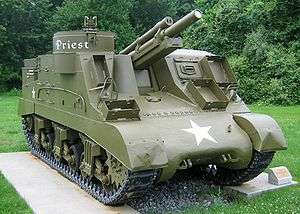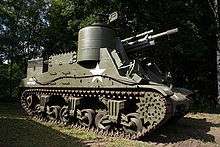M7 Priest
The 105 mm Howitzer Motor Carriage M7 was an American self-propelled artillery vehicle produced during World War II. It was given the official service name 105 mm Self Propelled Gun, Priest by the British Army, due to the pulpit-like machine gun ring, and following on from the Bishop and the contemporary Deacon self-propelled guns.
| M7 Priest | |
|---|---|
 M7 preserved at Aberdeen Proving Ground, Maryland | |
| Type | Self-propelled artillery |
| Place of origin | United States |
| Service history | |
| Used by | U.S. Army Argentine army[1] Austrian Army[2] Belgian army British Army Canadian Army French Army Israel Defense Forces Italian Army Norwegian army Pakistan Army Philippine Army Philippine Constabulary Taiwanese Army Bundeswehr (West German Army) Yugoslav People's Army[3] |
| Production history | |
| Manufacturer | American Locomotive Company (M7) Pressed Steel Car (M7B1) Federal Machine and Welder (M7) |
| Produced | April 1942 – July 1945[4] |
| No. built | M7: 3489, M7B1: 826 M7B2: 127 converted from M7B1[4] |
| Variants | M7, M7B1, M7B2 |
| Specifications | |
| Mass | 50,640 lb (22.97 metric tons) |
| Length | 19 ft 9 in (6.02 m)[5] |
| Width | 9 ft 5 in (2.87 m) with sandshields |
| Height | 8 ft 4 in (2.54 m)[5] 9 ft 8 in (2.95 m) over AA machine gun |
| Crew | 8 [4] |
| Armor | 12–62 mm[5] |
Main armament | 105 mm M1/M2 Howitzer 69 rounds |
Secondary armament | 1 × 0.5 in (12.7 mm) M2 Browning machine gun 300 rounds |
| Engine | Continental R-975 C1/C4 Ford GAA (M7B1) 400 or 340 hp (298 or 254 kW) |
| Suspension | Vertical volute spring |
Operational range | 120 mi (193 km) |
| Maximum speed | 24 mph (39 km/h) on road 15 mph (24 km/h) off road |
History
U.S. Army observers realized that they would need a self-propelled artillery vehicle with sufficient firepower to support armored operations. Lessons learned with half-tracks (such as the T19 Howitzer Motor Carriage (HMC) with a 105 mm howitzer on the M3 Half-track chassis) also showed that this vehicle would have to be armored and fully tracked. It was decided to use the M3 Lee chassis as the basis for this new vehicle design, named T32.[6] The pilot vehicles used the M3 chassis with an open-topped superstructure, mounting an M1A2 105 mm howitzer, with a machine-gun added after trials. The T32 was accepted for service as the M7 in February 1942 and production began that April. The British Tank Mission had requested 2,500 to be delivered by the end of 1942 and a further 3,000 by the end of 1943, an order which was never fully completed.[7][8]
As the M4 Sherman tank replaced the M3, it was decided to continue production using the M4 chassis (the M4 chassis was a development of the M3). The M7 was subsequently supplanted by the M37 HMC (on the "Light Combat Team" chassis that also gave the M24 Chaffee light tank).[8] While the first M7s were produced for the U.S. Army, some were diverted to support the British in North Africa. Ninety M7s were sent to the Eighth Army in North Africa, which was also the first to use it, during the Second Battle of El Alamein, along with the Bishop, a self-propelled gun based on the 87.6 mm calibre Ordnance QF 25-pounder gun-howitzer.[9]
The British had logistical problems with the M7, as it used U.S. ammunition that was not compatible with other British guns and had to be supplied separately.[9] The problem was resolved in 1943 with the Sexton, developed by the Canadians on an M3 chassis, using the standard British QF 25-pounder.[6] The British used the M7 throughout the North African and Italian campaigns. The 3rd and 50th British, and 3rd Canadian divisions that landed on Sword, Juno and Gold beaches at the start of the Allied invasion of Normandy had their artillery regiments equipped with the M7; these were replaced by the standard towed 25-pounder guns of the infantry in early August.[10][11] The M7 was also used in Burma and played a significant part in the Battle of Meiktila and the advance on Rangoon in 1945. After the Sexton appeared, most British M7s were converted into "Kangaroo" armored personnel carriers.

During the Battle of the Bulge, each U.S. armored division had three battalions of M7s, giving them unparalleled mobile artillery support.[12] A total of 3,489 M7s and 826 M7B1s were built. They proved to be reliable weapons, continuing to see service in the U.S. and allied armies well past World War II.[4][13]
Korean War
M7 Priests remained in use during the Korean War, where their flexibility, compared to towed artillery units, led the U.S. Army on the path to converting fully to self-propelled howitzers.[14] The limited gun elevation of the M7 (35 degrees) hampered its ability to shoot over the tall Korean mountains, so 127 M7B1s were modified to permit the full 65 degrees elevation in a model known as the M7B2. After the Korean War, many of these were exported to NATO countries, notably Italy and Germany.[15]
Israeli M7 Priests
Israel acquired a number of M7 Priests during the 1960s and employed them in the Six-Day War, the War of Attrition and the Yom Kippur War. In the last conflict, three M7 units, the 822nd, 827th and 829th Battalions in the IDF Northern Command, supported the occupation of the Golan Heights.[16]
West German M7 Priests
The new West German Bundeswehr received 127 Priests as its first self-propelled artillery vehicle. They entered service in 1956 and were used until the early 1960s. One surviving vehicle is now shown at the Deutsches Panzermuseum Munster (German Tank Museum Munster). A second has been fully restored in American world war 2 colours, and resides at the Australian Armour and Artillery Museum, Cairns Australia.
Variants

- M7
- The first M7s produced were based on modified M3 Lee medium tank chassis. To maintain a low silhouette, the howitzer elevation had to be restricted to 35°. In May 1942, after only a month of production, the vehicle was altered to increase its ammunition stowage from 57 to 69 rounds. This was achieved by placing seven rounds on the left wall and five on the right.[4] The M7 also went through a fairly rapid shift from being based on the M3, to having more commonality with the M4 Sherman. The first major example was an adoption of the M4's three-piece housing, single-piece casting and suspension. In British service, some M7s carried a radio set, which took the place of 24 rounds of ammunition.[13]
- M7B1
- Completing the shift, the M7B1 was fully based on the M4A3 Sherman chassis. 826 M7B1 were produced from March 1944 to February 1945.[4]
- M7B2
- During the Korean War, the limited elevation of the howitzer became noticeably problematic. 127 M7B1 were modified to permit an elevation of 65° to increase the effective range of the howitzer. The machine gun mount also had to be raised to give a 360° firing arc.[4]

- "Defrocked Priest"
- As one part of the Allied effort to capture Falaise and break out from the Normandy beachhead, 72 M7s had their main guns removed in the field for service as armoured personnel carriers and were first used in Operation Totalize. These field modified vehicles were referred to as "Defrocked Priests", "Unfrocked Priests" or as "Holy Rollers". The work was done in one week by 250 personnel from 14 British and Canadian Royal Electrical and Mechanical Engineer units.[17] 36 vehicles each were allocated to the 4th Infantry Brigade of the 2nd Canadian Division and the 154th (Highland) Brigade of the 51st (Highland) Division, which led the attack.[18]
- Kangaroo
- A Canadian armored personnel carrier conversion of the M7 for use by British and Commonwealth units in northern Europe.[19] The Kangaroo could carry 20 infantry plus a crew of two. A total of 102 were converted between October 1944 and April 1945. The name "Kangaroo" became generic for all conversions of armored fighting vehicles into personnel carriers, including Ram tank conversions.[13]
- 25pdr Howitzer Motor Carriage T51
- M7 fitted with 25 pounder gun in July 1942.[20]
British SPG naming scheme
A British self-propelled gun armed with the Ordnance QF 25-pounder in design from 1941 was nicknamed Bishop as its appearance was said to resemble a bishop's mitre and a replacement, the US 105 mm Howitzer Motor Carriage M7, was called "Priest", as part of its superstructure was said to resemble a pulpit. Following this line of names, a 1942 self-propelled gun armed with the QF 6 pounder was named Deacon and a 1943 weapon carrier with the QF 25-pounder was called Sexton.
See also
- G-numbers (SNL G128)
- List of "M" series military vehicles
- M37 105 mm Howitzer Motor Carriage
- M108 howitzer
Notes
- Tracol, Xavier (October 2011). "Blindorama : L'Argentine 1926–1945". Batailles et Blindés (in French). No. 45. Caraktère. pp. 4–7. ISSN 1765-0828.
- "Rearming Austria: WWII weapons". wwiiafterwwii.wordpress.com. 14 June 2015.
- Kočevar, Iztok (August 2014). "Micmac à tire-larigot chez Tito: L'arme blindée yougoslave durant la Guerre froide" [The Yugoslav armored arm during the Cold War]. Batailles et Blindés (in French). No. 62. Caraktère. pp. 66–79. ISSN 1765-0828.
- Zaloga, Steven J. (2013). M7 Priest 105mm HMC. Oxford, United Kingdom: Osprey Publishing. p. . ISBN 978-1-78096-023-4.
- Icks, AFV No. 26
- Bishop, p. 120.
- Icks, R. AFV Profile 26 – Hellcat, Long Tom and Priest
- Chamberlain & Ellis British and American Tanks of World War II 1969 p. 138
- Bishop, p. 121.
- John Keegan, Six Armies in Normandy, The Viking Press, New York, 1982, pp. 126–27
- Advanced Squad Leader, British Vehicle Notes, The Avalon Hill Game Co., Baltimore, MD, 1988, p. H61
- Collins, Michael. King, Martin. Voices of the Bulge: Untold Stories from Veterans of the Battle of the Bulge. MBI Publishing Company, 2011. p. 193
- Norris, John (2012) World War II Tanks and Trucks The History Press. ISBN 0-75249-073-7
- Gourley, Scott R. "The Korean War's Land Battle Legacy". Defense Media Network. Retrieved 30 March 2016.
- Zaloga, Steven J. (2013). M7 Priest 105mm Howitzer Motor Carriage. Osperey Publishing. p. 45. ISBN 978-1-78096-025-8. Retrieved 31 March 2016.
- Asher, Dani (2014). Inside Israel's Northern Command: The Yom Kippur War on the Syrian Border (2016 US ed.). Lexington, Kentucky: University of Kentucky Press. ISBN 978-0-8131-6766-4. Retrieved 31 March 2016.
- Ken Tout, A Fine Night For Tanks – The Road to Falaise, Sutton Publishing Ltd., Stroud, Gloucestershire, UK, 1998, pp 40 – 41
- Advanced Squad Leader, British Vehicle Notes, The Avalon Hill Game Co., Baltimore, MD, 1988, p. H63
- Jones, Richard. Tanks. Zenith Imprint, 2004. P.44
- Chamberlain & Ellis,p139
References
- Doyle, David. Standard Catalog of U.S. Military Vehicles. Krause Publications, 2003
- Bishop, Chris. The Encyclopedia of Weapons of World War II. Sterling Publishing Company, Inc., 2002
- Collins, Michael. King, Martin. Voices of the Bulge: Untold Stories from Veterans of the Battle of the Bulge. MBI Publishing Company, 2011
- Jones, Richard. Tanks. Zenith Imprint, 2004
- TM 9-2800 Standard Military Motor Vehicles. dated 1 September 1943
- TM 9-731E
- TM 9-1725
- TM 9-1750A
- TM 9-1750B
- TM 9-1750C
- TM 9-1750D
- TM 9-1750K
- TM 9-1751
- TM 9-1825A
- TM 9-1825B
External links
| Wikimedia Commons has media related to M7 Priest. |